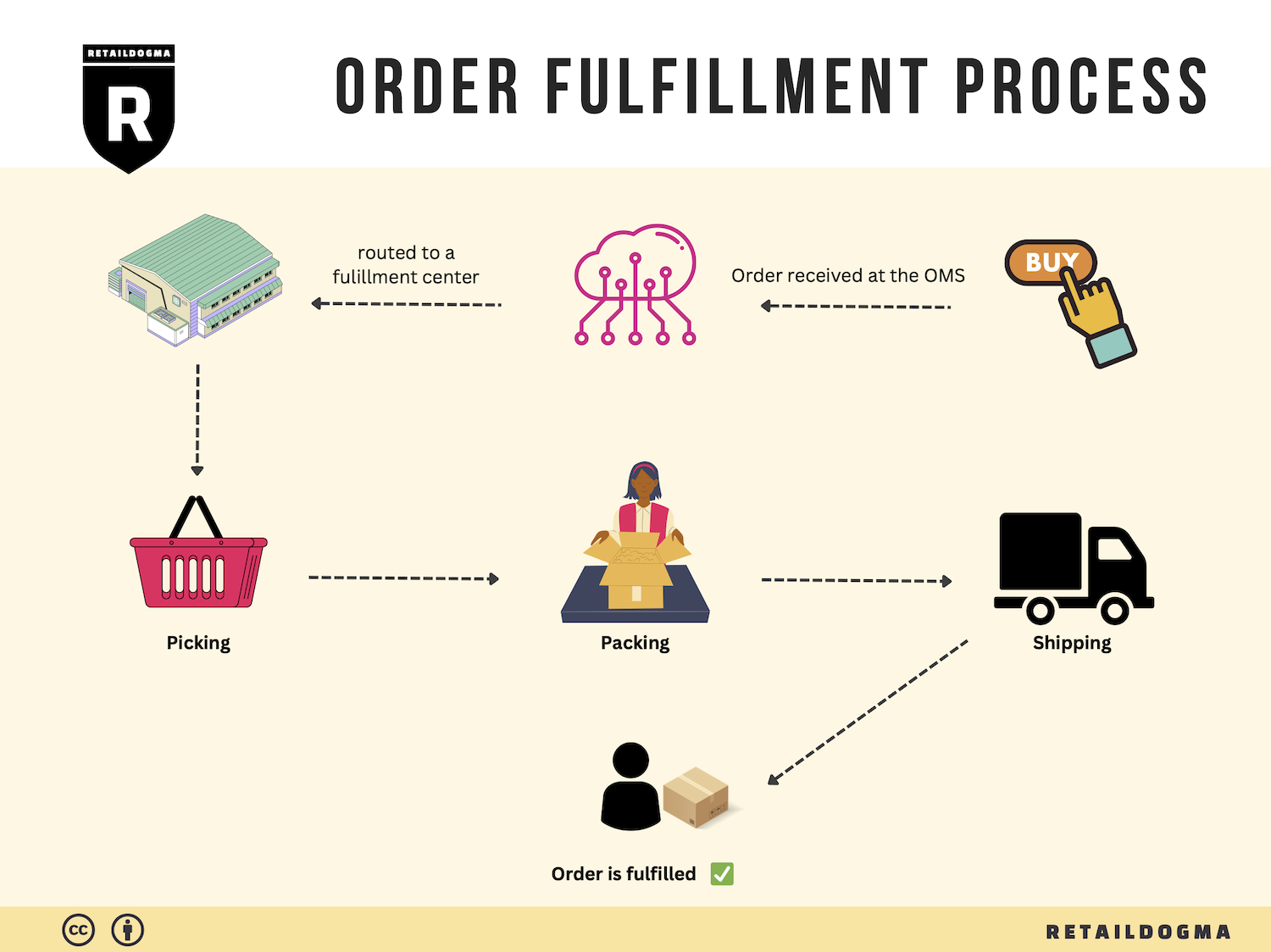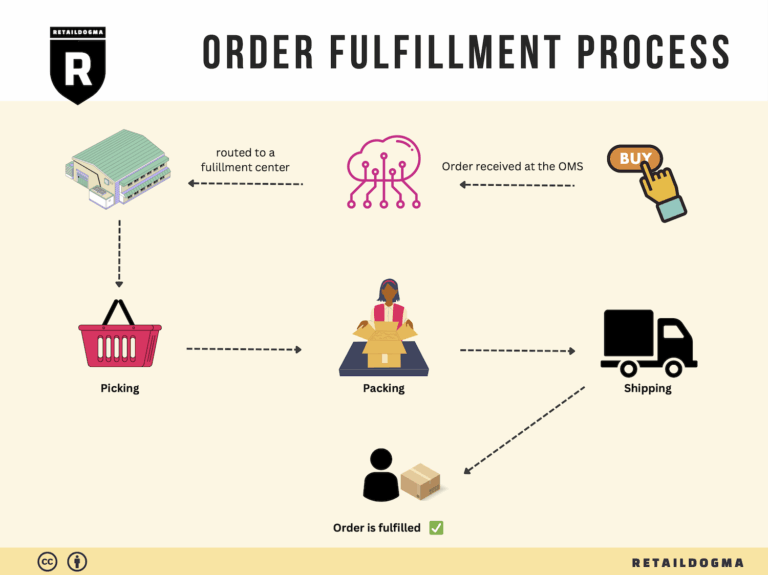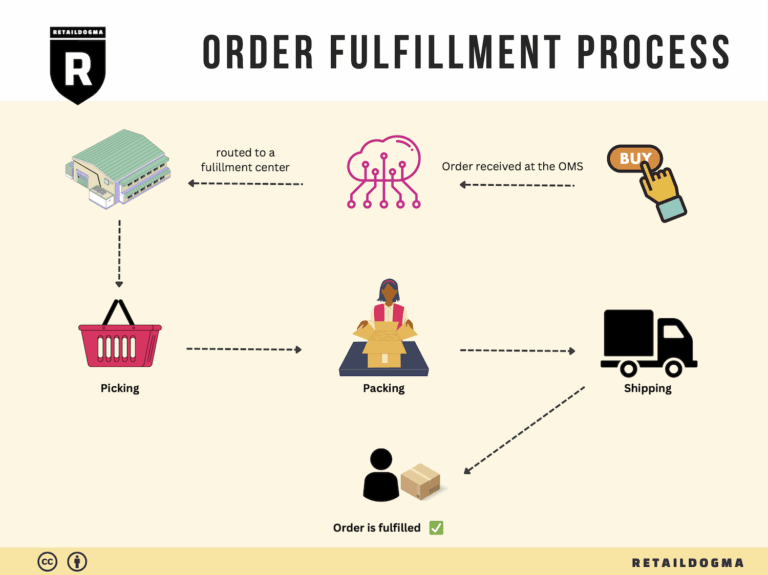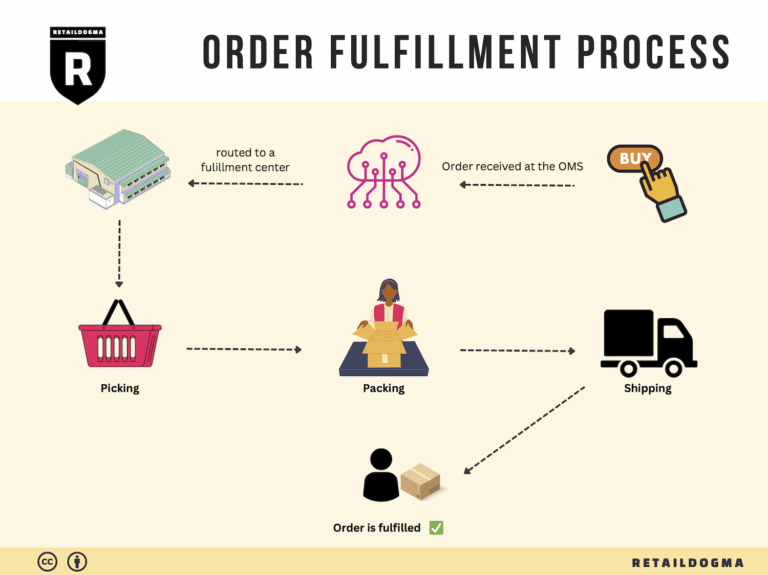How Order Fulfillment Works: A Step-by-Step Guide for Businesses
What is E-commerce Fulfillment? An Introduction for Growing Businesses
Overcoming the Overwhelm of Order Fulfillment
As an e-commerce business owner, you may find yourself drowning in a sea of packing materials, shipping labels, and customer inquiries. The excitement of growing sales can quickly turn into a logistical nightmare as you juggle the demands of fulfilling orders alongside managing other essential aspects of your business. The fulfillment process—getting your products to your customers—is critical, yet it often becomes a source of stress and frustration.
At its core, e-commerce fulfillment is the systematic process of receiving, processing, and delivering orders to customers. This includes everything from inventory management and order processing to shipping and returns. For many growing businesses, mastering this process is essential for scaling operations and ensuring customer satisfaction. However, the complexities of fulfillment can be overwhelming, especially as order volumes increase.
This guide aims to demystify e-commerce fulfillment and provide you with the insights needed to navigate this critical aspect of your business. We will explore various fulfillment models, including self-fulfillment, third-party logistics (3PL), and fulfillment by Amazon (FBA). Each model has its own advantages and challenges, and understanding these will help you determine the best approach for your business.
In addition to models, we will cover core fulfillment services such as inventory storage, order processing, packaging, and shipping. We’ll provide practical tips on how to choose the right fulfillment partner, what to look for in terms of reliability and scalability, and how to evaluate pricing structures.
Our goal is to empower you to make informed decisions about your logistics operations. By the end of this guide, you should feel confident in your understanding of e-commerce fulfillment and equipped to implement strategies that will streamline your processes, improve customer satisfaction, and ultimately drive growth.
With the right knowledge and resources, you can transform fulfillment from a burdensome task into a seamless operation that supports your business’s success. Let’s dive in and explore how to take control of your fulfillment strategy.
What You’ll Learn In This Guide
- What is E-commerce Fulfillment? An Introduction for Growing Businesses
- The Order Fulfillment Process: From ‘Buy’ Button to Customer’s Door
- Comparing Fulfillment Models: In-House vs. 3PL vs. Dropshipping
- A Deep Dive into Amazon FBA: Pros, Cons, and Who It’s For
- Core Services Offered by Fulfillment Centers
- How to Choose a Fulfillment Partner: A 6-Point Checklist
- Understanding Fulfillment Pricing: A Breakdown of Common Fees
- Frequently Asked Questions (FAQs) about Fulfillment
- Conclusion: Is Outsourcing Fulfillment the Right Move for Your Business?
- Important Disclaimer
The Order Fulfillment Process: From ‘Buy’ Button to Customer’s Door
1. Receiving Inventory
The order fulfillment process begins with receiving inventory, a critical step that sets the foundation for efficient operations. When new stock arrives, it must be carefully checked against purchase orders to ensure accuracy. This involves verifying quantities, inspecting for damages, and confirming that the correct items have been delivered. The key term here is SKU (Stock Keeping Unit), which is used to uniquely identify each product for tracking purposes.
Proper receiving procedures are essential for maintaining inventory integrity. Any discrepancies at this stage can lead to stockouts or overstock situations, both of which can negatively impact sales and customer satisfaction. Efficient receiving also helps streamline subsequent processes, as accurate data will feed into inventory management systems, ensuring that stock levels are correctly updated.
2. Warehouse Storage
Once inventory has been received and verified, the next step is warehouse storage. This involves organizing products in a manner that maximizes space and minimizes retrieval time. Effective warehouse layout is crucial, as it directly influences the efficiency of order picking later on. Utilizing a systematic approach, such as ABC analysis, can help prioritize storage based on the frequency of item sales.
Proper storage is vital for maintaining product quality and accessibility. Items should be stored in a way that minimizes damage and allows for easy identification. Efficient storage solutions can reduce the time spent searching for products, thus speeding up the overall fulfillment process. Additionally, a well-organized warehouse can accommodate fluctuations in inventory levels, which is particularly important during peak seasons.
3. Order Picking
Order picking is the process of retrieving items from storage to fulfill customer orders. This step typically begins when a customer places an order and is notified through an order management system. A critical component of this phase is the pick list, which outlines the items to be collected, their locations, and quantities needed.
Efficient order picking is essential for maintaining customer satisfaction. The quicker and more accurately orders are picked, the faster they can be shipped. Businesses can implement various picking methods, such as single order picking, batch picking, or zone picking, depending on their order volume and warehouse layout. Streamlining this process not only enhances operational efficiency but also reduces the likelihood of errors, which can lead to returns and dissatisfied customers.
4. Order Packing
After items have been picked, they move to the packing stage. This involves placing products into appropriate packaging, which protects them during transit. Packing materials must be chosen carefully to ensure that they provide adequate protection while also being cost-effective. Important considerations include the size of the box, the use of dunnage (packing materials that cushion items), and the inclusion of packing slips or invoices.

Effective packing is crucial for delivering a positive unboxing experience. A well-packed order not only reduces the risk of damage during shipping but also reflects the brand’s commitment to quality. Furthermore, efficient packing processes can help minimize shipping costs, as using the right box size and materials can prevent overpaying for shipping fees. Businesses should also consider eco-friendly packaging options, as sustainability is increasingly important to consumers.
5. Shipping & Delivery
The final step in the order fulfillment process is shipping and delivery. Once an order is packed, it must be labeled and handed over to a carrier for delivery. This stage involves choosing the right shipping method based on cost, speed, and customer preferences. Businesses need to stay updated on shipping rates and options provided by different carriers to ensure they are offering competitive choices.
Effective shipping and delivery practices are vital for customer satisfaction and retention. Providing customers with tracking information allows them to monitor their orders, reducing inquiries and enhancing the overall experience. Additionally, timely delivery can set a business apart from competitors, as consumers increasingly expect fast and reliable service. As e-commerce continues to grow, optimizing shipping processes will be essential for scaling operations and maintaining a loyal customer base.
In summary, understanding and mastering each step of the order fulfillment process is crucial for e-commerce businesses aiming to scale. By focusing on receiving, storage, picking, packing, and shipping, businesses can create a streamlined operation that enhances efficiency and customer satisfaction.
Comparing Fulfillment Models: In-House vs. 3PL vs. Dropshipping
Fulfillment Models Overview
When it comes to order fulfillment in e-commerce, selecting the right model is crucial for operational efficiency and scalability. Each fulfillment method—In-House Fulfillment, Third-Party Logistics (3PL), and Dropshipping—comes with its own set of advantages and disadvantages. Understanding these differences can help business owners and operations managers make informed decisions as they scale their logistics.
| Model | Who Handles Inventory | Best For (Business Stage) | Key Advantage | Key Disadvantage |
|---|---|---|---|---|
| In-House Fulfillment | The business owner | Startups & Established Businesses | Full control over inventory and fulfillment process | Time-intensive and costly as order volume increases |
| Third-Party Logistics (3PL) | A third-party provider | Growing & Scaling Businesses | Cost-effective, scalable, and access to expertise | Less control over the fulfillment process |
| Dropshipping | Suppliers | Startups & Low-Capital Businesses | Minimal upfront investment and no inventory risk | Lower profit margins and less control over shipping |
In-House Fulfillment
In-house fulfillment involves the business owner managing all aspects of inventory storage, order processing, packaging, and shipping. This model is typically adopted by startups or small businesses when order volumes are low and manageable. The primary advantage of in-house fulfillment is that it provides complete control over the entire process—from inventory management to customer service. This allows for personalized packaging and branding, which can enhance the customer experience. However, as order volumes increase, the disadvantages become apparent. The time and labor required for packing and shipping can quickly become overwhelming, leading to inefficiencies. Moreover, the costs associated with shipping, storage space, and materials can add up significantly. As a business scales, the limitations of in-house fulfillment can hinder growth and distract from core activities like marketing and product development.
Third-Party Logistics (3PL)
Third-party logistics providers specialize in handling logistics and fulfillment tasks for e-commerce businesses. They manage inventory, order processing, warehousing, and shipping, allowing business owners to focus on other critical aspects of their operations. This model is particularly beneficial for growing and scaling businesses that experience fluctuating order volumes. The key advantage of using a 3PL is the cost-effectiveness that comes from leveraging their established networks and bulk shipping rates. Additionally, 3PLs often have sophisticated technology systems that provide real-time inventory tracking and analytics, which can improve operational efficiency. However, the trade-off is a loss of control over the fulfillment process. Businesses may find it challenging to ensure that their branding and customer service standards are maintained, as they are relying on an external provider. Moreover, switching 3PLs can be complicated, making it essential to choose a reliable partner from the start.
Dropshipping
Dropshipping is a fulfillment model where the retailer does not keep products in stock. Instead, when a customer places an order, the retailer purchases the item from a third-party supplier who then ships it directly to the customer. This model is ideal for startups or businesses with limited capital, as it requires minimal upfront investment and eliminates the need for inventory storage. The primary advantage of dropshipping is the low financial risk, as businesses only pay for goods after making a sale. This allows for greater flexibility in product offerings and enables entrepreneurs to test new markets without significant financial commitment. However, dropshipping comes with its own set of challenges. Profit margins are often lower compared to other models, as suppliers take a cut of the sale. Furthermore, businesses have limited control over shipping times and product quality, which can lead to customer dissatisfaction. Delays in shipping or issues with product quality can tarnish a brand’s reputation, making it crucial for dropshippers to choose reliable suppliers.
Conclusion
Choosing the right fulfillment model is essential for e-commerce success. In-house fulfillment offers control but can become cumbersome as order volumes rise. Third-party logistics provide scalability and cost savings but at the expense of some control over the process. Dropshipping minimizes financial risk, making it appealing for startups, yet it presents challenges in terms of profit margins and quality control. Ultimately, the best fulfillment model depends on the specific needs of the business, its growth stage, and its operational capabilities. By carefully assessing these factors, e-commerce businesses can select a fulfillment strategy that aligns with their goals and positions them for success.
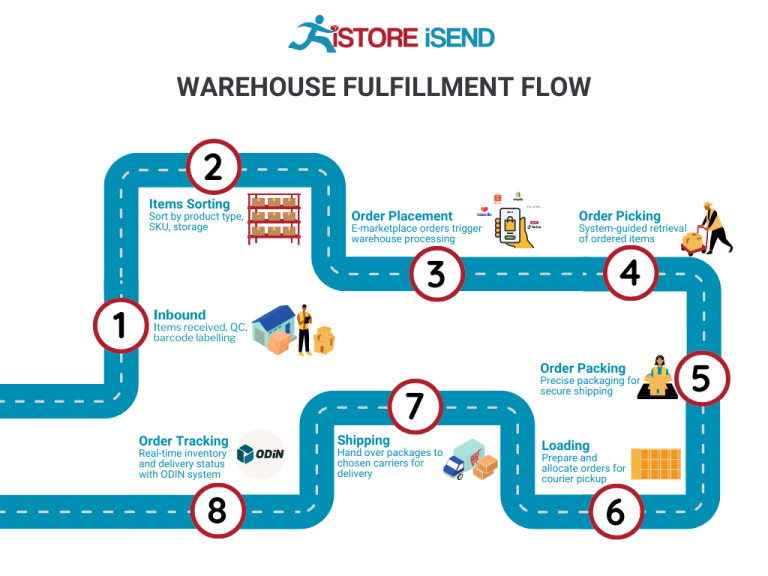
A Deep Dive into Amazon FBA: Pros, Cons, and Who It’s For
Understanding Fulfillment by Amazon (FBA)
Fulfillment by Amazon (FBA) is a service offered by Amazon that allows e-commerce sellers to store their products in Amazon’s fulfillment centers. Amazon then takes care of storage, packaging, shipping, and customer service for these products. When a customer orders a product, Amazon handles the entire order fulfillment process, including shipping the item directly to the customer. This service can significantly streamline logistics for businesses, especially those looking to scale rapidly.
How FBA Works
-
Sign Up and Set Up: Sellers must first create an Amazon seller account and enroll in FBA. After that, they can list their products as FBA items.
-
Shipping Inventory: Sellers send their products to Amazon’s designated fulfillment centers. Amazon provides guidelines on how to prepare and package items for shipping.
-
Storage: Once the products arrive at Amazon’s warehouses, they are stored until sold. Inventory levels can be monitored through the seller dashboard.
-
Order Fulfillment: When a customer places an order for an FBA product, Amazon picks, packs, and ships the product on behalf of the seller. This includes providing customer service and handling returns.
-
Payments: After an order is fulfilled, Amazon transfers the proceeds to the seller’s account, minus applicable fees.
Pros of Using FBA
-
Prime Eligibility: One of the most significant advantages of FBA is that products are automatically eligible for Amazon Prime. This means sellers can reach millions of Prime members who prefer fast, free shipping, significantly boosting visibility and sales.
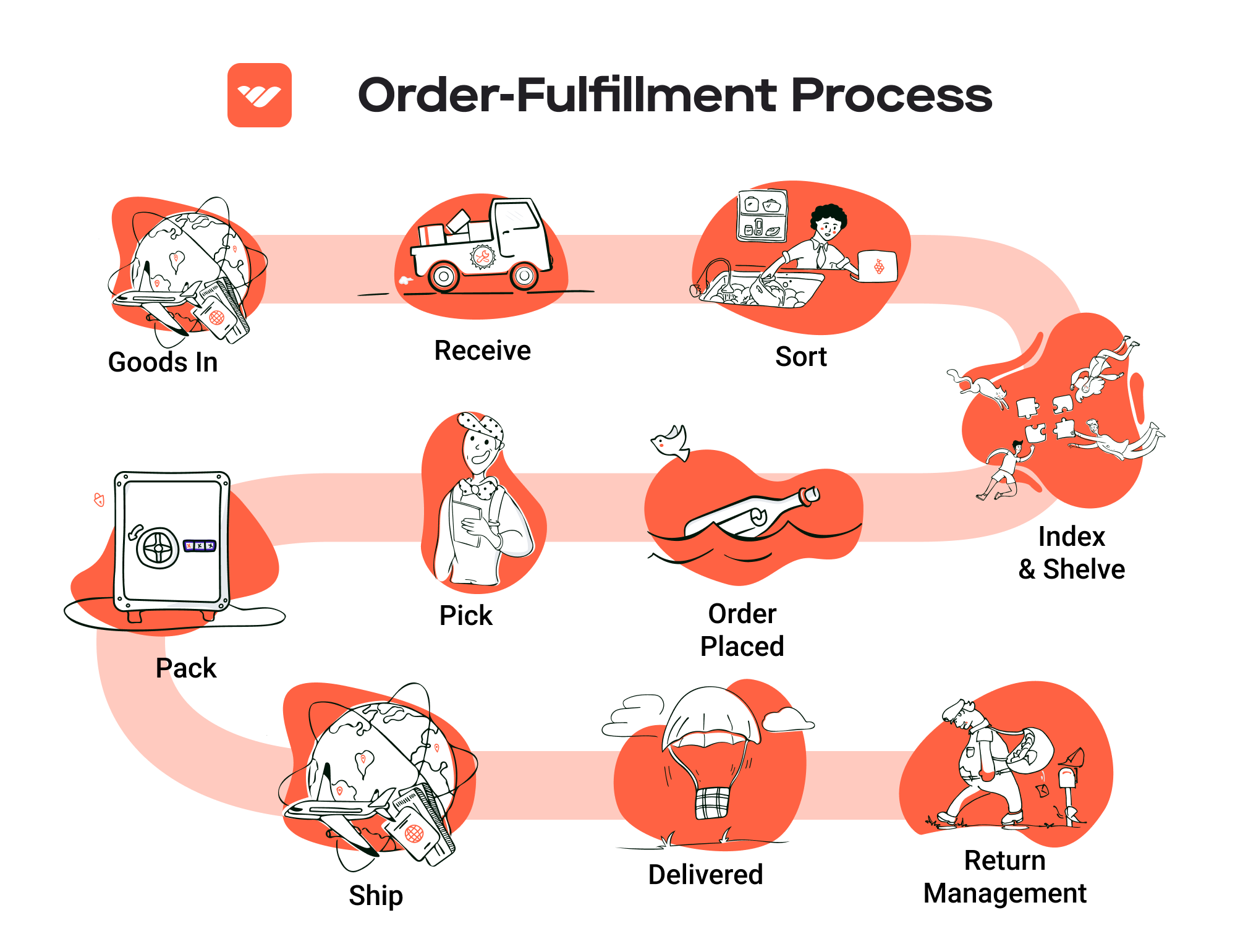
-
Customer Trust: Amazon is a well-established and trusted brand. By using FBA, sellers benefit from Amazon’s reputation, which can enhance customer trust and lead to higher conversion rates.
-
Multi-Channel Fulfillment: FBA is not limited to Amazon sales. Sellers can also use FBA to fulfill orders from other sales channels, such as their own websites or other marketplaces. This flexibility can simplify logistics and inventory management.
-
Scalability: FBA allows businesses to scale without the burden of managing logistics. As sales increase, Amazon can handle the increased order volume without the seller needing to invest in additional infrastructure.
-
Customer Service and Returns Handling: Amazon manages customer service inquiries and returns for FBA orders, freeing sellers from these time-consuming tasks.
Cons of Using FBA
-
High Fees: While FBA offers many benefits, it comes with a cost. Sellers must pay storage fees for keeping their inventory in Amazon’s warehouses and fulfillment fees for each order processed. These costs can add up, particularly for low-margin products.
-
Strict Inventory Rules: Amazon has specific guidelines and restrictions regarding inventory management, including limits on the number of units that can be stored. Sellers must comply with these rules to avoid penalties or removal of their listings.
-
Commingling Risks: FBA products can be commingled with inventory from other sellers. This means that if a customer receives a damaged or defective product, it can be challenging to pinpoint which seller is responsible. This risk can potentially harm a seller’s reputation.
-
Loss of Control: By utilizing FBA, sellers relinquish some control over the fulfillment process. This can lead to issues with packaging, shipping speed, and overall customer experience if Amazon’s service does not meet expectations.
-
Inventory Management Challenges: Sellers need to keep track of their inventory levels closely to avoid running out of stock or incurring long-term storage fees for unsold items. This can require sophisticated inventory management practices.
Who is FBA Best For?
Fulfillment by Amazon is particularly beneficial for:
-
Startups and Small Businesses: Companies that are just starting or those with limited resources can leverage FBA to access Amazon’s vast customer base and logistics capabilities without the need for significant upfront investment in warehousing and fulfillment.
-
Businesses with High Sales Volume: Sellers with a proven track record of high sales or those in competitive niches can benefit from the increased visibility and logistical support that FBA provides.
-
Sellers Looking to Scale: For businesses aiming to grow quickly, FBA provides the necessary infrastructure to handle increased order volumes without the need for additional personnel or logistics management.
-
Brands Focused on Customer Experience: Companies that prioritize customer service and fast shipping can enhance their offerings by using FBA, as Amazon’s fulfillment network is designed to meet these needs efficiently.
-
Multi-Channel Sellers: For businesses that sell across multiple platforms, FBA’s multi-channel fulfillment capability allows for streamlined logistics, making it easier to manage orders from various sources.
In conclusion, while Fulfillment by Amazon presents numerous advantages that can significantly enhance an e-commerce business’s logistics and customer reach, it also comes with challenges that need careful consideration. Sellers must weigh the pros and cons based on their specific business needs, sales volume, and long-term goals to determine if FBA is the right fit for their operations.
Core Services Offered by Fulfillment Centers
Inventory Management & Warehousing
Inventory management and warehousing are foundational services provided by fulfillment centers, crucial for e-commerce businesses looking to scale efficiently. This service encompasses the storage, tracking, and management of products within a warehouse environment.
Fulfillment centers utilize advanced inventory management systems that allow businesses to monitor stock levels in real-time, which helps prevent stockouts and overstock situations. By integrating these systems with e-commerce platforms, businesses can automatically update inventory counts as orders are placed, ensuring that customers have accurate information about product availability.
Benefits:
1. Optimized Storage Solutions: Fulfillment centers provide space for inventory that is often far more efficient than self-fulfillment. They utilize advanced storage techniques, such as shelving and pallet racking, which can maximize space and reduce costs associated with warehousing.
-
Scalability: As e-commerce businesses grow, their inventory needs will change. Fulfillment centers can scale storage capacity up or down based on demand, allowing businesses to adapt without the financial burden of maintaining excess space.
-
Improved Accuracy: The use of technology in inventory management reduces human error. Automated systems enhance the accuracy of inventory counts, leading to better order fulfillment and customer satisfaction.
Pick and Pack Services
Pick and pack services refer to the process of selecting items from inventory and preparing them for shipment. This is a critical step in the order fulfillment process, as it directly affects shipping speed and accuracy.
Fulfillment centers streamline the pick and pack process through organized inventory layouts and efficient workflows. They employ trained staff and often leverage automation technologies, such as conveyor belts and barcode scanners, to enhance efficiency.
Benefits:
1. Faster Order Processing: With optimized workflows and trained personnel, fulfillment centers can significantly reduce the time it takes to process orders. This speed is essential for meeting customer expectations, especially in a fast-paced e-commerce environment.
-
Error Reduction: Automated systems and systematic packing procedures help minimize picking errors. Fewer mistakes lead to increased customer satisfaction and reduce the costs associated with returns and exchanges.
-
Custom Packing Options: Fulfillment centers often offer various packing options, including branded packaging and eco-friendly materials. This customization can enhance the unboxing experience for customers, building brand loyalty.
Kitting and Assembly
Kitting and assembly services involve grouping individual items together to create a single product or package, often before they are shipped. This service is particularly beneficial for businesses that offer bundles, promotional kits, or require assembly prior to shipping.
Fulfillment centers have the expertise and resources to manage kitting and assembly efficiently, ensuring that products are packaged correctly and consistently.
Benefits:
1. Value-Added Services: Kitting allows businesses to create unique product offerings or promotional bundles, which can attract more customers and increase average order values.
-
Efficiency: By outsourcing kitting and assembly to fulfillment centers, businesses can save time and focus on core activities such as marketing and product development. This efficiency is especially important during peak seasons when order volumes surge.
-
Quality Control: Fulfillment centers often implement quality checks during the kitting process, ensuring that the final product meets the business’s standards before it reaches the customer. This attention to detail reduces the likelihood of returns and enhances brand reputation.
Returns Management (Reverse Logistics)
Returns management, or reverse logistics, is the process of handling returned products and managing the logistics associated with them. A well-organized returns process is vital for maintaining customer satisfaction and loyalty in e-commerce.
Fulfillment centers can streamline returns management by providing clear instructions for customers, processing returns quickly, and restocking items efficiently.
Benefits:
1. Enhanced Customer Experience: A smooth returns process can significantly improve customer satisfaction. Fulfillment centers often provide easy-to-follow return procedures, which can include pre-paid shipping labels and online tracking for returns.
-
Operational Efficiency: By outsourcing returns management, businesses can reduce the burden on their internal teams. Fulfillment centers can handle the inspection, restocking, and processing of returns, allowing e-commerce businesses to focus on growth.
-
Data Insights: Fulfillment centers can provide valuable data on return rates and reasons for returns. This information can help businesses identify trends, improve product quality, and refine marketing strategies to reduce future returns.
In conclusion, utilizing the core services offered by fulfillment centers can significantly enhance the operational efficiency of an e-commerce business. By leveraging these services, businesses can focus on scaling their operations while ensuring that their logistics and fulfillment processes are managed professionally and effectively.
How to Choose a Fulfillment Partner: A 6-Point Checklist
Location & Warehouse Network
Choosing a fulfillment partner with strategically located warehouses is crucial for minimizing shipping times and costs. A partner with a robust warehouse network can help you reach more customers faster and at a lower cost.
Why It’s Important:
– Reduced Shipping Costs: Proximity to major markets can significantly lower shipping expenses.
– Faster Delivery Times: Shorter distances mean quicker delivery, enhancing customer satisfaction.
Questions to Ask:
1. Where are your warehouses located, and how do they align with my target markets?
2. Do you have plans to expand your warehouse network in the future?
3. How do you handle shipping during peak seasons?
Technology & Integrations
A fulfillment partner’s technology stack can make or break your logistics operations. Efficient order management systems (OMS) and seamless integrations with your e-commerce platform are essential for smooth operations.
Why It’s Important:
– Real-Time Data: Access to live inventory levels and order statuses helps you manage your business effectively.
– Automation: Automated processes reduce errors and save time in order fulfillment.
Questions to Ask:
1. What technology do you use for inventory management and order processing?
2. Can your systems integrate with my existing e-commerce platform (e.g., Shopify, WooCommerce)?
3. Do you offer an API for custom integrations?
Specializations (e.g., Cold Storage, Oversized Items)
Different businesses have unique fulfillment needs based on their products. If you sell perishable items, oversized products, or fragile goods, you need a partner that can handle these special requirements.
Why It’s Important:
– Tailored Solutions: Specialized services ensure that your products are stored and handled correctly.
– Compliance: Certain products may require adherence to specific regulations (e.g., food safety standards).
Questions to Ask:
1. What types of products do you specialize in handling?
2. Do you have temperature-controlled storage for perishable items?
3. How do you manage shipping for oversized or fragile items?
Scalability & Capacity
As your business grows, your fulfillment partner must be able to scale operations accordingly. It’s essential to evaluate their capacity and flexibility to accommodate your growth.
Why It’s Important:
– Avoid Disruptions: A partner that can scale with you helps prevent service disruptions during peak periods.
– Long-Term Partnership: A scalable partner can support your business as it evolves, avoiding the need to switch providers frequently.
Questions to Ask:
1. How do you handle fluctuations in order volume, especially during peak seasons?
2. What is your maximum capacity for storage and order fulfillment?
3. Can you provide examples of how you’ve supported other clients during periods of rapid growth?
Pricing and Contracts
Understanding the pricing structure and contract terms is vital for maintaining healthy profit margins. Transparency in costs ensures there are no surprises that could impact your bottom line.
Why It’s Important:
– Budgeting: Knowing the costs upfront allows for better financial planning.
– Flexibility: Clear contract terms can provide the flexibility needed as your business needs change.
Questions to Ask:
1. What is your pricing model (e.g., per order, monthly storage fees)?
2. Are there any hidden fees I should be aware of (e.g., for returns, special handling)?
3. What are the terms for contract termination or adjustments?
Customer Support & Reviews
Effective customer support is crucial for resolving issues quickly and efficiently. Additionally, researching reviews can provide insight into the partner’s reliability and service quality.
Why It’s Important:
– Responsive Support: Quick resolutions to issues can minimize disruptions in your fulfillment process.
– Reputation Insight: Customer reviews can highlight potential red flags or strengths in a partner’s service.
Questions to Ask:
1. What level of customer support do you offer (e.g., 24/7 availability, dedicated account manager)?
2. Can you provide references or case studies from current clients?
3. How do you handle disputes or issues that arise during the fulfillment process?
By carefully evaluating potential fulfillment partners against this checklist, you can ensure that you select a provider that not only meets your current needs but can also support your business as it scales. Making an informed choice will contribute significantly to your operational efficiency, customer satisfaction, and ultimately, your bottom line.
Understanding Fulfillment Pricing: A Breakdown of Common Fees
Initial Setup Fees
Initial setup fees are often charged by fulfillment centers when you first begin using their services. These fees cover the costs associated with onboarding your business into their system, which may include account setup, integration with your e-commerce platform, and training on their processes. The amount can vary significantly based on the complexity of your operations and the fulfillment provider’s infrastructure.
For example, if you are integrating with a sophisticated warehouse management system (WMS), expect a higher fee compared to a basic integration. Some providers may also charge a one-time fee for creating custom packaging solutions if needed. It’s crucial to clarify what is included in the setup fee to avoid unexpected costs later.
Receiving Fees
Receiving fees are charged when your inventory arrives at the fulfillment center. These fees cover the labor and resources needed to unload, inspect, and store your products. Typically, this fee is calculated per pallet or per unit, depending on the fulfillment provider’s pricing model.
For instance, if you send a truckload of pallets, the receiving fee might be a flat rate per pallet. Conversely, if you’re sending smaller shipments of individual items, you might be charged per item received. It’s important to ensure that your shipments are properly labeled and organized to minimize receiving fees. Efficient shipping practices can help streamline this process and keep costs down.
Storage Fees (per pallet/bin)
Storage fees are recurring charges for keeping your products in the fulfillment center’s warehouse. These fees are usually calculated on a monthly basis and can be based on the space your inventory occupies, whether measured in pallets, bins, or cubic feet.
For example, if you have a large inventory and it occupies several pallets, you will be charged a monthly rate per pallet stored. Some fulfillment centers may offer tiered pricing, where the storage cost decreases as you store more pallets. It’s essential to monitor your inventory levels regularly to avoid unnecessary storage fees, especially if your inventory is not moving quickly.
Pick & Pack Fees (per item/order)
Pick and pack fees are charged for the labor involved in retrieving items from storage and packaging them for shipment. This fee is typically calculated per order or per item, depending on the fulfillment provider’s pricing structure.
For instance, if you have an order that includes multiple items, you may be charged a pick fee for each item picked, as well as a pack fee for the order as a whole. Some providers offer a flat rate for picking and packing, while others may have variable pricing based on the complexity of the order (such as custom packing requests). To minimize these fees, consider optimizing your product offerings and order combinations to reduce the number of items picked per order.
Shipping Fees
Shipping fees are one of the most significant costs in the fulfillment process and can vary widely based on several factors, including the carrier used, shipping destination, package weight, and shipping speed. Typically, fulfillment centers negotiate rates with carriers based on volume, which can lead to better pricing for businesses that ship frequently.
Shipping fees can be calculated based on weight, dimensions, and shipping zones. For example, shipping a small package within the same state will generally be cheaper than sending a large package across the country. Understanding the shipping options available and working with your fulfillment provider to select the most cost-effective carrier can help reduce overall shipping costs.
Tips for Getting an Accurate Quote
To ensure you receive an accurate quote for fulfillment services, consider the following tips:
-
Provide Detailed Information: When requesting a quote, provide comprehensive details about your products, including size, weight, and packaging requirements. This information will help the fulfillment center give you a precise estimate.
-
Ask About Pricing Structures: Clarify how fees are calculated, including any potential additional charges for services like returns or special handling. Understanding the pricing model is crucial to avoid surprises later.
-
Inquire About Volume Discounts: If you anticipate high order volumes, ask if the fulfillment center offers discounts for larger quantities of orders or storage.
-
Review Contracts Thoroughly: Before signing any agreements, review all terms and conditions related to fees. This will help you understand any potential costs that may arise during the fulfillment process.
-
Negotiate: Don’t hesitate to negotiate terms or ask for customized solutions based on your specific needs. Many fulfillment providers are willing to work with you to create a pricing structure that aligns with your business model.
By understanding these common fulfillment fees and actively engaging with potential providers, you can make informed decisions that support the efficient scaling of your e-commerce operations.
Frequently Asked Questions (FAQs) about Fulfillment
1. What is self-fulfillment in e-commerce?
Self-fulfillment refers to the process where an e-commerce business manages its own inventory storage, order processing, packing, and shipping without outsourcing these tasks to a third party. This approach is common for startups and small businesses that want to maintain control over their logistics and reduce initial costs.
2. What are the key steps in self-fulfillment?
The main steps in self-fulfillment include:
1. Processing Orders: Set up a system to receive and track customer orders promptly.
2. Inventory Management: Organize and store your products efficiently to facilitate easy picking.
3. Packing: Use appropriate packing materials to ensure products are protected during shipping.
4. Labeling and Shipping: Print shipping labels and choose the best carriers for delivery.
5. Tracking: Provide customers with tracking information to keep them updated on their orders.
3. What are the challenges of self-fulfillment?
Self-fulfillment can present several challenges, including:
– Scalability: As order volume increases, it can become increasingly difficult to manage fulfillment efficiently.
– Time Management: Fulfilling orders can consume valuable time that could be spent on other business functions like marketing or product development.
– Cost: Shipping costs may be higher without the bulk discounts that third-party logistics providers can negotiate.
– Space Limitations: Storing inventory at home can lead to clutter and operational inefficiencies.
4. When should I consider outsourcing fulfillment?
Consider outsourcing fulfillment when:
– Your order volume exceeds your capacity to manage efficiently.
– You’re experiencing significant growth and can no longer keep up with packing and shipping.
– You want to focus on scaling your business rather than getting bogged down in logistical tasks.
– You need to reduce shipping costs through bulk rates and better carrier relationships.
5. What is the difference between a warehouse and a fulfillment center?
A warehouse is primarily a storage facility for inventory, while a fulfillment center is designed specifically for order processing, packing, and shipping. Fulfillment centers often offer additional services like inventory management and returns handling, making them more suited for e-commerce businesses.
6. What is a 3PL (Third-Party Logistics)?
A 3PL is a service provider that manages logistics and fulfillment on behalf of a business. They handle storage, inventory management, order processing, shipping, and often returns. Using a 3PL can help businesses save time and reduce costs associated with fulfillment.
7. How much do fulfillment services cost?
The cost of fulfillment services varies widely based on factors such as order volume, the complexity of services needed, storage space, and shipping requirements. On average, businesses can expect to pay a combination of fixed monthly fees and variable costs based on the number of orders fulfilled and shipping rates.
8. How can I streamline my self-fulfillment process?
To streamline your self-fulfillment process, consider:
– Implementing an Order Management System (OMS): This helps automate order processing and tracking.
– Standardizing Packing Procedures: Create a consistent packing process to reduce time and errors.
– Using Quality Packing Materials: Invest in the right materials to protect items and reduce shipping costs.
– Scheduling Regular Shipping Times: Set specific times for shipping to maintain a routine.
9. What packing materials do I need for self-fulfillment?
Essential packing materials include:
– Boxes or Poly Mailers: Appropriate sizes for your products.
– Protective Materials: Bubble wrap, packing peanuts, or crinkle paper for cushioning.
– Packing Slips and Inserts: For customer communication and branding.
– Tape and Labels: For securely sealing packages and clear identification.
10. How can I handle returns effectively in self-fulfillment?
To manage returns effectively, establish a clear return policy and process. Include return instructions with every order, and consider using a return management system to track returns and restock inventory efficiently. Quick and efficient handling of returns can enhance customer satisfaction and loyalty.
Conclusion: Is Outsourcing Fulfillment the Right Move for Your Business?
Making the Decision: Outsourcing Fulfillment for Growth
Outsourcing fulfillment can be a transformative decision for e-commerce businesses aiming to scale efficiently. By partnering with a fulfillment service, you free up valuable time that can be redirected toward strategic initiatives such as marketing, product development, and customer engagement. This focus on growth is critical, especially as order volumes increase, and self-fulfillment becomes increasingly cumbersome.
One of the most significant advantages of utilizing a fulfillment service is scalability. As your business grows, so too will your order volume. A reputable fulfillment partner can accommodate this growth seamlessly, ensuring that you can handle peak seasons without the logistical headaches associated with self-fulfillment. This capability not only prevents operational bottlenecks but also enhances customer satisfaction by ensuring timely deliveries.
Additionally, fulfillment services bring expertise to the table. They have established relationships with shipping carriers and can negotiate better rates, reducing your overall shipping costs. This expertise extends to inventory management, returns processing, and order tracking, allowing you to provide a smoother, more professional customer experience.
However, the choice of a fulfillment partner is paramount. Not all providers offer the same level of service or flexibility, and selecting the right one can significantly impact your operational efficiency and customer satisfaction. Conducting a thorough audit of your current shipping processes is an excellent starting point. Evaluate your order volume, shipping costs, and the time spent on fulfillment tasks. This analysis will help you determine whether outsourcing is the right next step for your business.
In conclusion, while self-fulfillment may have served you well in the early stages, leveraging a fulfillment partner could be the key to unlocking your e-commerce business’s full potential. Take action today by assessing your current fulfillment process and exploring how outsourcing could streamline your operations and enhance your growth trajectory.
Important Disclaimer
⚠️ Important Disclaimer
The information in this guide is for educational purposes. Fulfillment services, pricing, and platform features change frequently. Always conduct your own due diligence and consult with providers directly before making business decisions.
